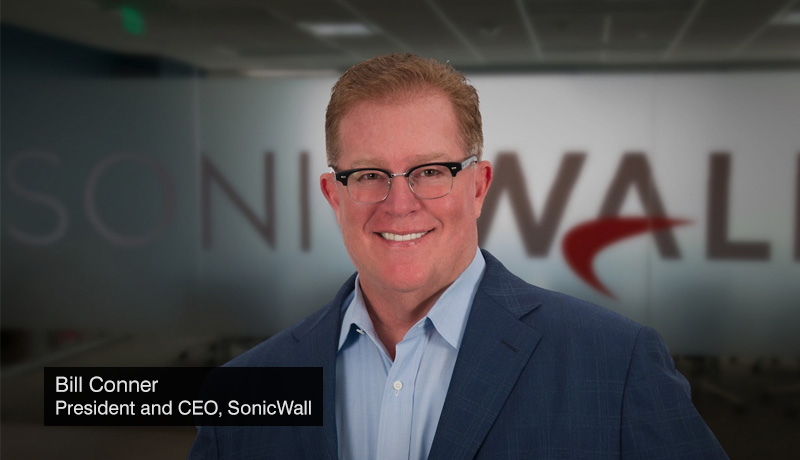
SonicWall is emphasizing the return of customer choice for securing and scaling a mix of cloud, hybrid and traditional environments.
“Too many times organizations have been forced to change the way they operate in order to secure access to their networks, data, devices and people,” said SonicWall President and CEO Bill Conner.
He added, “We’ve been busy innovating cloud and virtual solutions that help organizations secure complex blends of networks, including virtual, hybrid, cloud and on-premises deployments.”
SonicWall’s expanding virtual, cloud, and hybrid services take use of the company’s Boundless Cybersecurity strategy to give customers more deployment options while solving real-world problems faced by SMBs, businesses, governments, and MSSPs. The following are the core cloud solutions provided by SonicWall:
“The modern IT environment is rife with complexity that drives security and connectivity challenges, which can be further complicated when organizations require hybrid environments comprised of physical, virtual and SaaS offerings, and private and public cloud solutions,” said IDC Research Director Chris Rodriguez.
He also said, “Cybersecurity vendors that support these deployment options add tremendous financial and operational flexibility for their customers, and are also well suited for organizations that are in different stages of their cloud journey.”
SonicWall’s cloud innovation is driven by the need to solve complex security and connectivity concerns by providing customers and partners with more power, flexibility, and choice. SonicWall has worked with companies all around the world to create some of the most secure and reliable hybrid networks.
“The University of Pisa connects and secures a wide and distributed network of systems, users, applications and services to ensure our institution can provide the highest levels of on-campus and remote learning,” said University of Pisa CIO Antonio Cisternino.
He also commented, “It’s imperative that we’re able to use the same trusted security controls, regardless of how we deploy them. Through their growing range of virtual, cloud and hybrid offerings, SonicWall gives us that choice and flexibility without sacrificing the security standards we require to protect and enable students, faculty, and staff.”
SonicWall ensures that businesses may choose their own deployment methods and cloud migration time scales, rather than being forced into a vendor-first strategy. SonicWall empowers clients to deploy what works for their architecture — and adopt cloud transformation at their own speed — by offering cloud-based (e.g., virtual firewall and VPN), as-a-service (e.g., ZTNA, FWaaS), and on-premises (e.g., firewalls, VPN) alternatives.
SonicWall NSv virtual firewalls, Cloud Edge Defend Access zero-trust security, appliance-free SMA virtual private networks (VPN), and Cloud App Security to safeguard SaaS apps are among the virtual, cloud, and on-premises technologies used to secure these real-world hybrid settings.
With Zero-Touch Deployment features, organizations may further grow and extend distributed environments by simultaneously installing security across numerous locations — with minimal IT support.
With the rise of work-from-home options, businesses need a simple and secure way to link their employees to the resources they need, no matter where they are.
In a perimeter-less, cloud-first world, SonicWall supports zero-trust security as a principle of cybersecurity. SonicWall enables enterprises to connect remote users to on-premises resources, cloud-hosted apps, branch offices, and public clouds in a quick and straightforward manner.
SonicWall Cloud Edge Secure Access, the company’s zero-trust network access (ZTNA) product, swiftly grows security beyond the perimeter using modern zero-trust principles in as little as 15 minutes. As a result, logical trust zones are created, which authenticate each person, device, and location in order to grant them secure access to only the services and resources they require.
Unified Insights, a new feature in SonicWall Capture Security Center 3.0, integrates insights from all SonicWall devices together in a single, customized dashboard, including physical and virtual firewalls, wireless access points, switches, and endpoint security products. This eliminates the need to multi-task between several consoles by providing a central, easy-to-use location for monitoring environments and addressing difficulties.
Capture Security Center 3.0, when combined with SonicWall Analytics, can turn enormous volumes of data (from tens of thousands of firewall nodes) into actionable insights and defensive actions against hidden hazards across networks, apps, and people – all with the visibility, precision, speed and scale of the cloud.
By seamlessly integrating SonicWall physical and virtual firewalls when and where it makes sense for your business, SonicWall ensures that organisations can identify and block known and unknown cyberattacks across traditional networks, public and private cloud infrastructure, and virtual environments, regardless of deployment strategy. This ecosystem is built on SonicWall’s cloud-based Advanced Threat Protection (ATP) multi-engine sandbox service, which protects against advanced cyber attacks such as never-before-seen malware and ransomware.